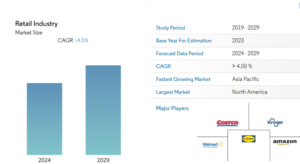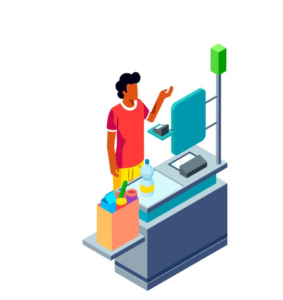
Unveiling the Top 10 Retail Trends Shaping 2024’s Shopping Landscape
Introduction:
As we stand on the threshold of 2024, the retail industry is on the brink of a profound transformation driven by the relentless advance of artificial intelligence (AI). In a realm where technology evolves at an unprecedented pace, discerning the trends shaping the future of retail becomes imperative for both businesses and consumers. A study by IBM projects a surge in AI adoption in retail from 40% to over 80% within three years, signifying a significant trend toward AI-powered retail environments. This article aims to shed light on the innovative ways retailers are leveraging AI, forecasting the top 10 biggest retail trends for 2024. The below figure shows that the retail industry market size will grow more than 4.5% between 2024-2029 with APAC being the fastest-growing market and North America being the largest market.

Source: Retail Industry Market Size – Mordor Intelligence

Figure- Retail Industry Growth Rate by Region (Source Mordor Intelligence)
1. Advanced AI Chatbots Redefining Customer Service:
The chatbot market is undergoing substantial growth, projected to reach USD 14.95 billion by 2028.
Chatbots are becoming more sophisticated, offering human-like experiences and anticipating customer needs.
Yaniv Hakim, Co-founder of CommBox, notes the ability of chatbots to react to customers’ emotions, ensuring a personalized and seamless experience.

2. Generative AI Enhancing Search Capabilities:
Retail giants like Amazon, Walmart, and Google are using generative AI to personalize search experiences.
Will Underwood, CEO of Optiversal, highlights the technology’s potential to capture new SEO demand and enhance marketing strategies.

3. AI-powered Call Centers Setting New Standards:
AI is transforming call centers, providing personalized recommendations and improving first-call resolutions.
Nikola Mrkšić, CEO & Founder of PolyAI, emphasizes the importance of personalization and seamless tech ecosystems in contact centers.
4. Generative AI Crafting the Perfect Soundtrack:
Generative AI is making waves in the audio space, creating professional soundtracks and enriching the in-store retail experience.
Ola Sars, CEO of Soundtrack Your Brand, sees retailers leveraging custom-made tech tools for the ideal brand-fit playlists.
5. Leveraging Universal IDs for Cookieless Advertising:
As the advertising industry shifts from traditional cookies, retailers are adopting Universal IDs powered by AI for targeted campaigns.
Cory Munchbach, CEO of BlueConic, emphasizes the significance of first-party data for personalized, privacy-respecting experiences.
6. Smart Systems Reducing Shoplifting in Self-Service Checkout:
AI-driven smart systems can detect anomalies, flag suspicious transactions, and reduce shoplifting in self-service checkout.
Kurt Staelens from FTI Consulting discusses the challenges of shrink in retail and the role of computer vision solutions.
7. AI Transforming the Retail Sales Floor:
Nearly 50% of retail respondents are actively using AI technology, creating interactive in-store solutions.
Keri Moore from Batteries Plus envisions a tech-amplified retail sales floor, with interactive displays, smart mirrors, and personalized digital signage.

8. AI-Enabled Smart Shelf Inventory:
AI-enabled smart shelves use sensors, RFID tags, and IoT connectivity for real-time data on product availability.
Ionut Vlad, Founder and CEO of Tokinomo, highlights how smart shelves offer detailed product information and personalized recommendations.
9. Emotional AI Revolutionizing Digital Advertising:
Emotional AI is transforming TV advertising by enabling emotionally charged interactions, creating deeper connections with viewers.
Tricia Allen from Reticle AI notes the ability of emotional AI to enhance consumer understanding and engagement in connected TV ads.

10. AI Mobile Messaging Chatbots Enhancing Customer Service:
Retailers are adopting AI mobile messaging chatbots to improve response times and streamline customer service.
Yaniv Hakim, Co-founder of CommBox, points out the increasing reliance on mobile devices, especially among Gen Z.
Conclusion
The future of retail is undeniably intertwined with the dynamic capabilities of artificial intelligence. From revolutionizing customer service with advanced chatbots to creating personalized shopping experiences through generative AI, the retail landscape is evolving at a rapid pace. As we embrace the top 10 retail trends for 2024, one thing becomes clear: the fusion of technology and commerce is not just a trend; it’s a new era of innovation that places the customer at the center of an unprecedented shopping experience.
Frequently Asked Questions:
How are AI chatbots evolving in 2024?
AI chatbots are becoming increasingly sophisticated, offering a more human-like experience. They can understand natural language, recognize emotions, and provide real-time assistance, making them a crucial component of customer service.
How is Generative AI used in retail search optimization?
Retail giants like Amazon and Walmart are harnessing Generative AI to enhance search capabilities. This technology personalizes search experiences, suggesting products based on consumer history and preferences, ultimately anticipating future needs.
What role does Emotional AI play in digital advertising?
Emotional AI is transforming TV advertising by enabling emotionally charged interactions. This technology enhances consumer understanding and engagement, creating deeper connections with viewers and signaling a shift towards emotionally intelligent advertising strategies in the retail sector.
How do AI-enabled smart shelves benefit retailers?
AI-enabled smart shelves use sensors, RFID tags, and IoT connectivity to provide real-time data on product availability. They automate stock tracking, inform stores when items are running low or misplaced, and allow for dynamic pricing strategies, ultimately optimizing inventory management and improving the in-store experience.
How are retailers leveraging AI in self-service checkout systems?
AI-driven smart systems in self-service checkout detect anomalies, flag suspicious transactions, and reduce the likelihood of shoplifting. Retailers are increasingly relying on AI to enhance security and streamline the checkout process, providing a seamless experience for customers.
What is the IoT in Retail Market Size?
The global Internet of Things (IoT) in retail market size was valued at USD 42.38 billion in 2022 and is expected to grow at a compound annual growth rate (CAGR) of 28.4% from 2023 to 2030 (Source Grandview Market Research).
What is the global VR (Virtual reality) in retail market size?
The global virtual reality retail market size was valued at USD 3.25 billion in 2022 and is expected to expand at a compound annual growth rate (CAGR) of 28% from 2023 to 2030. The growing trend of VR headsets in the retail sector is reshaping the customer shopping experience, resulting in a rapid market expansion during the forecast period (Source Grandview Market Research).


